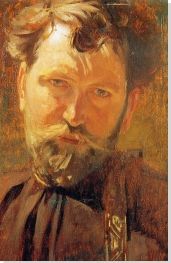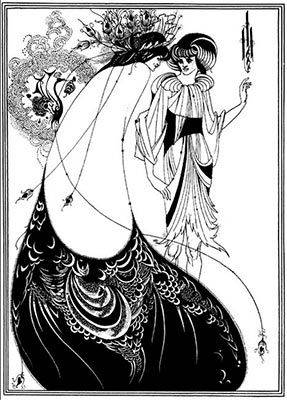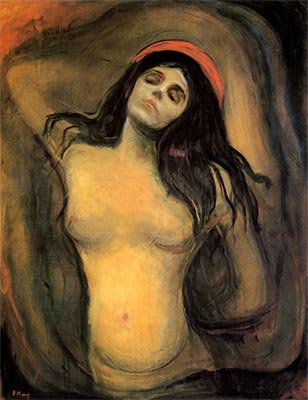Summary of Alphonse Mucha
Mucha was famous for his commercial posters, which had a wide audience, but he also worked in a variety of other media, including furniture, jewelry, and theatrical sets. He mostly worked in Vienna and Paris, but was also in Chicago, where he taught at the Art Institute, from 1904 to 1910. There, he introduced his interpretation of the "new art" to a United States audience. The densely patterned posters epitomize the Art Nouveau interest in natural forms, decoration, and a rejection of the anonymity of mechanical production.
Accomplishments
- Women were a common theme in Mucha's work (and in Art Nouveau art in general). The femme nouvelle or "new woman" type was a favorite subject, since it served both allegorical and decorative purposes. Indeed, Mucha and his peers celebrated femininity as the antidote to an overly-industrialized, impersonal, "masculine" world.
- Mucha worked in a variety of media that were accessible to a wide audience, and so the reach of his art extended beyond the borders of "high art." Everything could be a work of art, encompassing a person's daily experience, from wallpaper to furniture to clothing to promotional posters around the city.
- Although Mucha is most associated with his Art Nouveau posters, he spent the latter of half of his career focused on projects of a nationalist character. Stirred by a pride in his country and an interest in its artistic traditions, Mucha sought to celebrate the history and mores of Czech culture.
Important Art by Alphonse Mucha
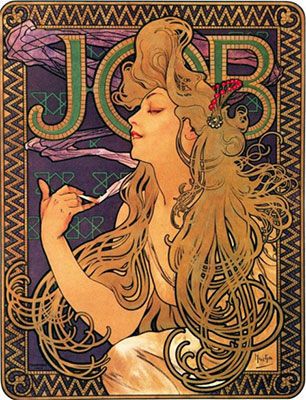
Job Cigarette Papers
This striking poster was created as an advertisement for the Job cigarette company. A beautiful woman with a lighted cigarette dominates Mucha's poster, the rising smoke intertwining with her swirling, Pre-Raphaelite hair and the Job logo. The poster's golden zigzag border, inspired by Byzantine mosaics, combines with the twirling smoke and the rich purple background to create a luxurious and sensual mood. The curving lines of the woman's hair and rising smoke stand out against the rhythmic lines of the zigzag frame.The very fact that this woman is smoking - let alone that she is somewhat eroticized - was scandalous, since no respectable woman of the time would smoke in public. Furthermore, her sensual tangle of cascading hair was daring, because respectable women of the era wore their hair tied up.
These significant breaks from tradition suggest that the smoker may be wanton and wild. She is lost in pleasure - quite possibly in the nude, her closed eyes and half smile suggesting ecstasy. Mucha depicts his smoking woman in the manner of a rapturous saint to advertise an everyday product, thereby revealing his great skill at blending art and commerce. He elevates the ordinary to a realm of mysterious beauty.
Color lithograph - Mucha Museum, Prague
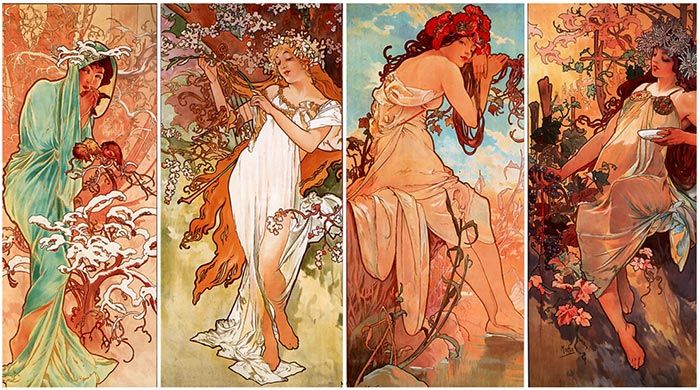
The Seasons
The first of Mucha's much-copied pânneaux décoratifs (decorative panels), The Seasons (1896), shows the harmonious cycles of nature. Four seasonal beauties, each set against a distinct natural backdrop, convey the mood of each season. Innocent Spring stands among white blossoms, charming birds; Summer lounges among red poppies; bountiful Autumn rests with chrysanthemums, gathering fruit; and Winter,in a snowy landscape, huddles under a cloak with a small bird. The decorative style of the images illustrates Mucha's artistic influences and interests. This style reflects his debt to Japanese woodcuts, as well as to Hans Makart's The Five Senses (1879), while his association of women with a subtle undercurrent of death and rebirth speaks to his interest in symbolism. The choice of medium reflects his interest in making art available to all, since the panels were created as affordable art for private homes.
Mucha's desire to see mass-produced art reach the widest possible audience was quickly achieved; his pânneaux were so popular that he soon created other, similar works: The Flowers (1898), The Arts (1898), The Times of the Day (1899), The Precious Stones (1900), and The Moon and the Stars (1902).
Color lithograph - Mucha Museum, Prague
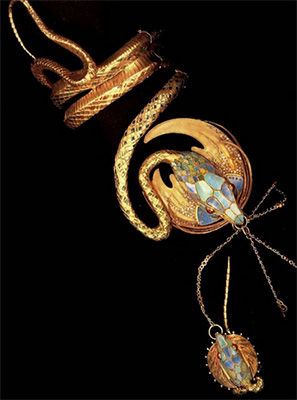
Snake Bracelet with Ring
Mucha's interest in expanding the boundaries of art and design led to beautiful collaborations with the Parisian goldsmith Georges Fouquet. The most iconic of these is this sparkling snake bracelet, created for his mentor, the actress Sarah Bernhardt. (Mucha shot to fame when he illustrated Bernhardt's theatre poster Gismonda in 1894.) Thick gold coils twine about the wrist, the tail slithers up the arm, while the winged head and mosaic of opals, rubies and diamonds sits on the hand. Fine gold links and hinges allow movement and connect to a snake-head ring.
Not only is this bracelet an example of Mucha's connection to the world of theater, but it also reveals his interest in bringing together traditions from East and West. The bracelet is also impressively utilitarian: Mucha's son Jiri said that the bracelet was designed to accommodate Bernhardt's arthritic wrist! Mucha and Fouquet worked together for three years, resulting in a treasury of elaborate jewels for Fouquet's display at the 1900 Exposition Universelle.
Gold, enamel, opal, ruby and diamond - Mucha Museum, Prague
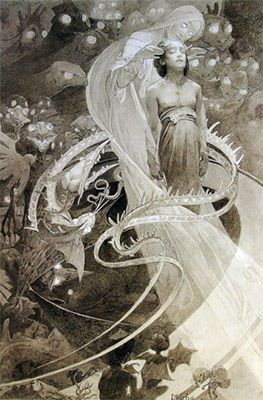
Le Pater
Created at the turn of the century, this illustrated book marks the point when Mucha's own spiritual philosophy entered his work. In his book, Mucha created an image for each line of the Lord's Prayer,with his own symbolic interpretations thereof. This included mysterious motifs ranging from an eight-pointed star to stars, crescent moons, circles and many other esoteric images drawn from the Kabbalah and Masonic philosophy, among other sources. It was a universal call from the human to the divine, a prayer to reach a higher spiritual plane.
Mucha's imagery blended his own Catholic traditions with his interest in the occult, such as Spiritualism (he conducted seances and psychic experiments), and Masonic beliefs (he was a practicing Freemason). He considered the book to be his masterpiece, and said he put his soul into it. Century Magazine called him a "New Mystic" and noted that in Le Pater, Mucha's God was "no longer the benign or wrathful Father, but a mysterious Being whose shadow fills the earth. Nature is personified as a luminous, adolescent giant, and Love descends from heaven in the guise of a woman."
Illustrated Book - Mucha Museum, Prague
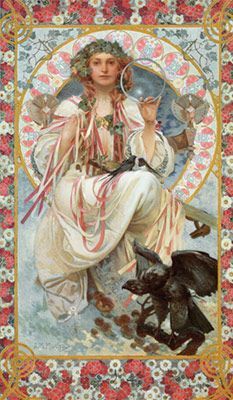
Slavia
Commissioned by the millionaire and philanthropist Charles Crane upon the marriage of his daughter Josephine, this painting is a portrait of Josephine as the Slav goddess, Slavia. The work says more about Mucha's use of the image of Slavia as a symbol of his homeland than it does about Josephine herself. Mucha painted Slavia/Josephine as his ultimate 'Mucha woman,' with her hair, body, and clothing creating graceful forms in front of a richly ornamented background. Presumably, Charles Crane was pleased with this painting, since he would later go on to finance Mucha's most ambitious project, the Slav Epic (1911-26).
The goddess Slavia was a recurring icon both in Mucha's commercial and fine art work, and on posters and logos for the Slavia Bank. Slavia, a symbol of the unified Slav nation, was a well-known allegory in Slavic culture, appearing in epic songs as well as legends. Mucha revisited the subject matter ten years later, when hewas commissioned to design banknotes for the newly founded Czechoslovakia. He used the image of Slavia on the 100 korun banknote. Mucha also planned to use the image of Slavia in his stained glass window in St Vitus Cathedral, but was ultimately persuaded to replace her with the Christian St. Wenceslas instead.
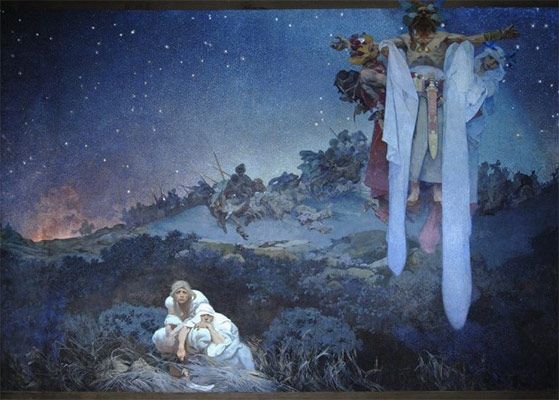
The Slavs in Their Original Homeland
This is the first of the twenty massive canvasses (some measuring 6x8 meters) that made up Mucha's life-long project - The Slav Epic (1911 - 1926), in which he sought to create a national iconography for the much-persecuted Slav people while also uniting them with spiritual virtue. In the painting, innocent medieval farmers are menaced by Huns invading from the East as well as by Germanic tribes from the West. Mucha's colors are imbued with a symbolic significance that enhances the painting's power and beauty. The dominant blue represents a spiritual realm, with the contrasting white of the Slavs suggests purity. Both the spiritual blue and the pure white contrast with the reds and oranges of the burning flames of a torched village in the background. The godlike figure hovering at the upper right is flanked by a young man and woman, symbols of war and peace. The message seems to be one of hope for the Slavs - hope that they may have peace and prosperity even in the shadow of their many struggles and wars.
Mucha toiled for two decades to complete the twenty canvases that comprized this series. Drawing on his extensive experience working with stage sets and theater, he used photographs of costumed models to compose his images. The first eleven canvases were publicly exhibited in Prague in 1919. Although the canvases received a positive reception from the general public, critics were unimpressed and were wary of the overtly nationalistic subject matter. The last canvas, The Apotheosis of the Slavs, which depicts the joy of Slav independence, was completed in 1926. Mucha gave his series to the city of Prague and the series was also exhibited around the United States, to much acclaim.
Tempura and oil on canvas - Prague, Czech Republic
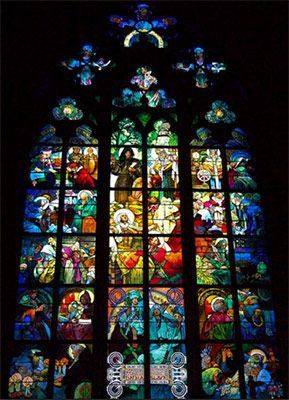
Stained Glass Window
This stunning stained glass window casts brilliant light into the north nave of St Vitus' Cathedral in Prague. It creates incredible bursting light, color, and activity - with the central flaming gold and red colors fading into the cool blues and greens on the outer scenes. At the center is the boy Saint Wenceslas (the Czech patron saint) with his grandmother, Saint Ludmila. They are in prayer, the red hues around them perhaps foreshadowing the martyrdom to come. 36 episodes from the lives of the ninth Century Saints Cyril and Methodius, famous for baptizing the Slavs into Christianity, surround the central scene.
Wenceslas personifies the free Czechoslovakian nation. Christ looks down from above, while the 'Mucha women' represent the young people of the new nation. The secular world intrudes into this religious scene, as the window bears the logo of the new Slavia Bank who had funded the project. Not only is Mucha's window an achievement for its colorful exuberance and dynamic design, but it is also emotionally and psychologically deep. The profound humanity and emotion of the figures comes through in their facial expressions and body language.
Stained glass - St Vitus Church, Prague
Biography of Alphonse Mucha
Childhood and Education
Mucha was raised in the shadow of two powerful cultural forces: The Catholic Church and the Slav's desire for independence from the Austrian Empire. Excited by light and color, Mucha's earliest memory was of Christmas tree lights. A baroque fresco in his local church piqued his interest in art, and he moved to Vienna, where he took an apprenticeship as a stage set painter. Surrounded by the explosion of art in the Austrian capital, he learned of and greatly admired the work of Hans Makart, among others.
To make a living he executed portrait commissions. This led him to an important mentor, Count Khuen-Belasi, who hired him to paint murals in Emmahof Castle. Mucha's own poverty and popularity was brought into sharper clarity while he worked in the castle. His poverty was such that his one and only pair of trousers grew so shabby that a group of society girls bought him a new pair. Count Khuen-Belasi paid for Mucha's training in fine art in Munich, where he continued to work as an illustrator, most notably for Krokodil magazine, where he developed his distinctive calligraphic style.
By 1887 he was in Paris studying at the Academie Julian and Academie Colarossi. Here, artists such as Vuillard and Bonnard were becoming prominent. Along with these artists came new ideas about what art could do. Art came to be seen as a pursuit that could reveal greater mysteries, and as something to incorporate into everyday life and objects. These ideas began to develop into what would become the Art Nouveau conception of art in daily life.
Early Training
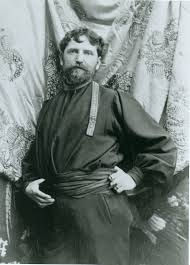
Mucha scraped together a living illustrating magazines and advertisements. He and Paul Gauguin shared a studio on the Rue Grande Chaumiere. Mucha rigged the studio so that when the door opened beautiful music played. An interviewer in 1900 called the studio, "simply marvelous." It was full of exotic objects and bohemian writers, artists, and musicians who came to work and play. An infamous photograph of Gauguin playing the Harmonium with no trousers on captures the playful and free-spirited mood of their studio. It was here that Mucha first explored his interest in the occult with August Strindberg, and engaged in hypnotic and psychic experiments with Albert de Rochas and the astronomer Camille Flammarion.
Mucha shot to fame in 1894 with his theatre poster for Gismonda. The leading actress, Sarah Bernhardt was an internationally famous, and by association with her, Mucha quickly became famous as well. Bernhardt put him under contract, and Mucha created many promotional posters for her, as well as costumes and stage sets.
Amid the Belle Époque posters Mucha's style was a hit. Collectors stole his posters from billboards, dubbing his style "Le Style Mucha." But he felt art must do more than be visually pleasing; it must communicate a spiritual message and uplift its viewers. Mass-produced art appealed to him, since it could reach and inspire more people. In posters for perfume, beer, biscuits, bicycles, and Job Cigarettes (1896) he blurred the barrier between fine art and commercial art, between commerce and philosophy.
Drawing from the influences of the Pre-Raphelites, Hans Makart, and Japanese wood cuts Mucha developed his unique style. His style was organic and ornate, graceful and dynamic, with curving, swooping lines and Byzantine borders, lettering, and frames. His iconic 'Mucha woman' had curves, flowing hair, pastel robes, and often a halo of light or flowers, which recall the haloes from the religious icons he saw throughout his boyhood. Mucha's women burst with life; in stark contrast to the Symbolist femme fatales, (such as Edvard Munch's Madonna) Mucha's women are not a dangerous temptation to be resisted.
His innovative decorative panels, The Seasons (1896), further pushed art into private homes. Inspired by friends such as Auguste Rodin, Mucha experimented with sculpture and partnered with the goldsmith Fouquet to produce fantastic jewels from gold, ivory, and precious stones. He even created a radiant "Mucha world" in Fouquet's Rue Royale boutique where his statues, stained glass, fountains, mosaics, sculpture, and lighting turned shopping into a theatrical experience.
After exhibitions in Vienna, Prague, Budapest, Munich, Brussels, and London, he was hailed as the world's greatest decorative artist. To spread his ideas he issued two template books Documents Decoratifs (1902) and Figures Decoratifs (1905). These books were filled with designs for jewelry, wallpaper, stained glass, furniture, and figures, and together they became the Art Nouveau bible. In spite of his association with Art Nouveau, Mucha rejected the label, insisting that art was eternal.
At the turn of the century Mucha explored his spiritual beliefs in his illustrated book Le Pater (1899), which was a reinterpretation of the Lord's Prayer decorated with Byzantine, Catholic, and Masonic symbols. The book reflects Mucha's belief that art had moral and political purpose. It was meaningless if, as he put it, "my homeland was left to quench its thirst on ditch water." He felt crushed by fame, which he described as "robbing me of my time and forcing me to do things that are so alien to those I dream about." His artistic dream was to create an epic painting cycle that would serve as a beautiful illustration of Slav history and that would inspire the Slavic quest for freedom.
Mature Period
To fund his monumental painting epic, Mucha made multiple trips to the USA to find a patron. By executing society portraits in 1909 Mucha finally found his man, the philanthropist Charles Crane, who would finance him for the next twenty years. Mucha returned to Prague in 1910 and dedicated himself to his Slav Epic, while simultaneously executing projects such as the Lord Mayor's Hall ceiling which bore the inscription: "Though humiliated and tortured you will live again, my country!" In 1918 Mucha's dream was realized when Czechoslovakia was recognized as an independent nation. Delighted, he set about designing the new nation's postage stamps, banknotes, and coat of arms. In a studio in Zbiroh Castle he toiled at his giant canvases, some of which measured 6x8 meters, and were rigged like ship's sails to haul them up and down. His work required research, and he made regular field trips throughout the Balkans and to consult with historians to ensure that every battle and costume was depicted accurately. His works began to give the Pan-Slavic vision international attention. In 1919 the first phase of his epic work was on tour in the USA, attracting 50,000 visitors per week.
Later Period
In 1926 Mucha completed his final canvas, No.20, The Apotheosis of the Slavs, showing the new republic protected by Christ, under a rainbow of peace. In 1928 at the nation's 10th anniversary celebrations he donated the Slav Epic to the City of Prague and proceeded to execute a stunning stained glass window in St. Vitus Cathedral (1931). As the decade progressed his hope of security was threatened by the Nazis but, still a believer in the power or art, he began a triptych The Three Ages (1936-38) to argue for reason, wisdom, and love as the paths to peace. The Nazi invasion of Czechoslovakia in 1939 put an end to Mucha's hopes, work, and ultimately his life. Classed as a 'reactionary' he was interrogated by the Gestapo, and, already weak with a lung infection he died in 1939.
The Legacy of Alphonse Mucha
Under Nazi occupation the Slav Epic was hidden underground, and under Communism his art continued to be viewed as decadent and bourgeois and did not receive public display. His son Jiri Mucha, devoted much of his life to reviving his father's reputation. The 1960s Art Nouveau revival saw Mucha's style much-copied on British posters for Pink Floyd and The Incredible String Band. And in the USA, one poster for a 1966 San Francisco 'happening' was a direct copy of Mucha's Job Cigarette Paper (1896). Mucha has also been acknowledged as an influence by the Stuckist painter Paul Harvey and also on cartoon and fantasy art, as that of Japanese Manga artists like Naoko Takeuchi.
Influences and Connections

-
![Paul Gauguin]() Paul Gauguin
Paul Gauguin -
![Auguste Rodin]() Auguste Rodin
Auguste Rodin ![August Strindberg]() August Strindberg
August Strindberg
![Bob Masse]() Bob Masse
Bob Masse![Naoko Takeuchi]() Naoko Takeuchi
Naoko Takeuchi![Paul Harvey]() Paul Harvey
Paul Harvey
Useful Resources on Alphonse Mucha
- MuchaOur PickBy Sarah Mucha
- Alphonse Maria MuchaOur PickBy Jiri Mucha
- The Graphic Work of Alphonse MuchaBy Jiri Mucha
- Alphonse Mucha: MasterworksBy Rosalind Ormiston
 Ask The Art Story AI
Ask The Art Story AI